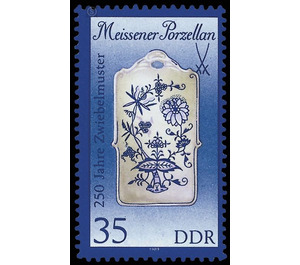Commemorative stamp series - Germany / German Democratic Republic 1989 - 35 Pfennig
Theme: Art & Culture
| Country | Germany / German Democratic Republic |
| Issue Date | 1989 |
| Face Value | 35.00 |
| Color | blue |
| Perforation | K 12 1/2: 13 and K 14 |
| Printing Type | offset |
| Stamp Type | Postage stamp |
| Item Type | Stamp |
| Chronological Issue Number | 2985 |
| Chronological Chapter | GER-DDR |
| SID | 952540 |
| In 26 Wishlists | |
Famous decors on Meissen porcelain On the occasion of the 250th anniversary of the use of the onion pattern as decoration on Meissen porcelain, the Ministry of Posts and Telecommunications of the German Democratic Republic issues four multi-colored special postage stamps, one after the other. Special stamp from 18 April to 17 June 1989 Famous decors on Meissen porcelain - ONION PATTERN - The Meissen porcelain manufactory is the first and oldest porcelain manufactory in Europe. Since its founding in 1710 by the Saxon Elector and Polish King August II, called AUGUST THE STRONG, Meissen porcelain is becoming increasingly popular. This applies in particular to a décor that has prevailed for 250 years in its original unchanged form and has become synonymous with MEISSEN: the cobalt-blue ONION PATTERN. The desire for precious and rare East Asian (Chinese and Japanese) porcelains in the early years of European porcelain production led to eager imitation, both in design and decor design. Very popular were East Asian blue paintings. Already Johann Friedrich BÖTTGER (1682-1719), the inventor of the European hard porcelain, searched for the color corresponding to the Chinese blue, but only after his death succeeded one of his collaborators named David KÖHLER in 1720 and for a long time carefully preserved secret of the Meissen manufactory remained. 1739 celebrated the ZWIEBEILMUSTER in its usual design as cobalt-blue underglaze decoration its creation. The name is due to the misunderstanding of native of East Asia pomegranate whose stylized shape resembles the onion. The onion pattern decoration includes symbols based on Far Eastern beliefs. In addition to pomegranate and bamboo, other East Asian plants and fruits are depicted, symbolically classifying man as the center of earthly life in the eternal cycle of becoming and passing away. Traditionally, this decoration is painted on the more than 400 different shapes assortment of dishes "Neuer Ausschnitt", whose original form was created by Johann Joachim KAENDLER (1706-1775), the ingenious master and founder of the European porcelain style, around 1745. In addition, the onion pattern adorns another 300 forms that have been developed to date, so that the entire onion pattern assortment includes 700 different parts. The color still prepared according to the original recipe is applied by hand in underglaze painting on the incandescent to 900 ° C, which requires high perfection and safety, as the porous body immediately absorbs the color and eliminates any correction. After glazing, a second firing takes place at a much higher temperature of 1450 ° C and the onion pattern decoration beneath the crystal-clear glaze appears in brilliant cobalt blue. On the occasion of the 250th anniversary of the ZWIEBELMUSTER in 1989, four selected pieces of porcelain with this decor will be presented on special postage stamps. The colored design is subordinated to the decor and is done in blue and white. The stamp - the lettering "MEISSEN PORZELLAN" with the crossed BLUE SWORDS - appears on all postage stamps, the occasion "250 years onion pattern" and the issuing country "DDR". 35 Pfennig-Weit: Bread Board In the continuous expansion of the "New Section" assortment, a bread board was created in 1855 with the form number 246 registered according to the mold directory, today 00230. Today, all articles are faithfully hand-sculpted and painted. The priority of the bulb pattern still belongs as before the VEB Staatliche Porzellan Manufaktur Meissen. Since 1888, this décor in the base of the bamboo tree has additionally been wearing the crossed BLUE SWORDS.


